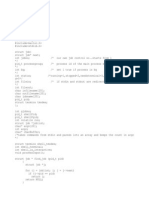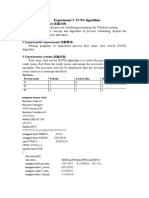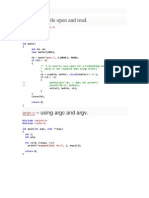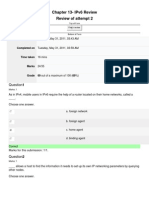0 ratings0% found this document useful (0 votes)
86 views《Operating Systems》-Experimental instruction-Experiment 2 Process Control
The experiment simulates process control using a simple structure. It establishes three queues - waiting, executing, and blocking - to represent process states. Transitions between the running, blocked, and ready states are also simulated. The code implements basic process control functions like creating new processes, executing processes, blocking/waking processes, and outputting the processes in each queue. Screenshots show running the interface and using functions to create, implement, block, and wake processes.
Uploaded by
BRANDY GANYIRECopyright
© © All Rights Reserved
Available Formats
Download as DOC, PDF, TXT or read online on Scribd
0 ratings0% found this document useful (0 votes)
86 views《Operating Systems》-Experimental instruction-Experiment 2 Process Control
The experiment simulates process control using a simple structure. It establishes three queues - waiting, executing, and blocking - to represent process states. Transitions between the running, blocked, and ready states are also simulated. The code implements basic process control functions like creating new processes, executing processes, blocking/waking processes, and outputting the processes in each queue. Screenshots show running the interface and using functions to create, implement, block, and wake processes.
Uploaded by
BRANDY GANYIRECopyright
© © All Rights Reserved
Available Formats
Download as DOC, PDF, TXT or read online on Scribd
You are on page 1/ 9
Experiment 2 Process Control
1 Experimental purpose 实验目的:
(1) To understand the concept of process;
(2) To use simple structure and control method to simulate process structure,
process state and process control.
2 Experimental requirements 实验要求:
PCB is used to represent the whole process entity, keyboard control method is
used to simulate the event generated in process execution, or mouse or keyboard
operation based on graphical interface is used to control process management content.
Set up three basic queues: waiting, executing and blocking for simulation. The
process management of operating system, the scheduling of simulation process, the
creation, execution, blocking, suspending and wakening of users are simulated.
A process can be in running, blocked, or ready state. Transitions between these
states are as shown in Fig. 2-1.
Figure 2-1 Transitions between three states
3 Experimental content 实验内容:
(1) Set up a node, namely PCB block, including user identification field, pointer
field, etc.
(2) Establish three queues (execute queue, ready queue and wait queue).
(3) According to the process state transition, implement the specific operation of
the three queues.
(4) Select state with switch selection statement.
program source code:
#include "stdio.h"
#include "dos.h"
#include "stdlib.h"
#include "conio.h"
#include "windows.h"
#define SEC 3
//#define NULL 0
/*定义结构体*/
typedef struct PCB
{
int PID; //进程控制号
int UID;//内部 ID 号
struct PCB * next;
}PCB;
PCB *really , *excute , *wait;
/*create queue header */
/*queue operation 入队*/
int enqueue(PCB *head , PCB *node)
{
PCB *p;
p = head;
if(p -> next == NULL)
{
head -> next = node;
return 1;
}
while(p)
{
if(p -> next == NULL)
{
p -> next = node;
return 1;
}
else p = p -> next;
}
}/*enquue*/
/*dequeue 出队列 */
PCB * dequeue(PCB *head)
{
PCB *p;
p = head;
if(p -> next == NULL)
{
return NULL;
}
else
{
p = p -> next;
head -> next = p -> next;
p -> next = NULL;
return p;
}/*head to next*/
}/*dequeue*/
/*PCB operate*/
/*新建进程*/
void create()
{
PCB *p;
p = (PCB*)malloc(sizeof(PCB));
p -> next = NULL;
printf("input PID and UID to a new process\n");
scanf("%d %d",&p -> PID,&p -> UID);
if(enqueue(really , p))
printf("create a process: PID = %d UID = %d\n", p -> PID , p -> UID);
else
printf("create Failed\n");
}/*create*/
/*执行 fexcute*/
int fexcute()
{
PCB *p = dequeue(really);
if(p == NULL)
{
printf("NO process in queue \n");
return 0;
}
else
{
enqueue(excute , p);
printf("add a process into excute queue process: PID = %d UID= %d \n" ,p->PID , p-
>UID);
return 1;
}
}/*excute*/
int suspend()
{
PCB *p = dequeue(excute);
if(p == NULL)
{
printf("NO process in queue \n");
return 0;
}
else
{
enqueue(really , p);
printf("add a process into really queue process: PID = %d UID= %d \n" ,p->PID , p->UID);
return 1;
}
}
int wake()
{
PCB *p = dequeue(wait);
if(p == NULL)
{
printf("NO process in queue \n");
return 0;
}
else
{
enqueue(really , p);
printf("add a process into wait really process: PID = %d UID= %d \n" ,p->PID , p->UID);
return 1;
}
}
int block()
{
PCB *p = dequeue(excute);
if(p == NULL)
{
printf("NO process in queue \n");
return 0;
}
else
{
enqueue(wait , p);
printf("add a process into wait queue process: PID = %d UID= %d \n" ,p->PID , p->UID);
return 1;
}
}/*block*/
/*输出队列 outputqueue*/
int outputqueue(PCB *head)
{
PCB *p;
if(head -> next == NULL)
{/*队列为空*/
printf("queue is null \n");
return 1;
}
p = head -> next; /*node pointer*/
while(p)
{/*打印 process id UID*/
printf("PID = %d UID = %d \n" , p -> PID , p -> UID);
p = p -> next;
}
return 0;
}
/*output 输出*/
int output()
{
printf("REALLLY QUEUE:\n");
outputqueue(really);
printf("EXCUTE QUEUE: \n");
outputqueue(excute);
printf("WAIT QUEUE: \n");
outputqueue(wait);
}/*output*/
/*init 初始化*/
int init()
{
PCB *p;
//clrscr();
really = (PCB*)malloc(sizeof(PCB));
really -> next=NULL;
excute = (PCB*)malloc(sizeof(PCB));
excute -> next=NULL;
wait = (PCB*)malloc(sizeof(PCB));
wait -> next = NULL;
printf("____________PROCESS SECHUDLE__________\n");
printf("now initing.....................\n");
printf("input PID and UID as integer , 0 0 as over\n");
while(1)
{
p = (PCB*)malloc(sizeof(PCB));
p -> next = NULL;
scanf("%d %d",&p -> PID , &p -> UID);
if(p -> PID == 0 && p -> UID == 0)
break;
else
{
if(enqueue(really , p))
printf("new process PID = %d UID = %d added!\n",p -> PID , p -> UID);
else return 0;
}
}
return 1;
}/*init*/
/*运行一个 process*/
int run()
{
PCB *p = excute;
int s = SEC;
if(excute -> next == NULL)
{
printf("no process in excute queue \n");
return 0;
}
else
{
p = excute -> next;
printf("system will sleep %ds as process running\n",s);
Sleep(3);/*sleep as process runing time*/
printf("process: PID = %d UID= %d excute successed..\n" , p -> PID , p -> UID );
excute -> next = p -> next;
free(p);
}
}
/*离开*/
void leave()
{
PCB *p,*t;
while(really->next || excute->next || wait->next)
{
p = really -> next;
while(p)
{
t = p -> next;
free(p);
p = t;
}
really -> next = NULL;
p = wait -> next;
while(p)
{
t = p -> next;
free(p);
p = t;
}
wait -> next = NULL;
p = excute -> next;
while(p)
{
t = p -> next;
free(p);
p = t;
}
excute -> next = NULL;
}
exit(0);
}/*leave*/
void help()
{
printf("_____________________HELP MENU_____________________\n");
printf("\t-h HELP show help option\n");
printf("\t-c CREATE create a new process , and put to really queue\n");
printf("\t-b BLOCK block a process in excute queue\n");
printf("\t-w WAKE wake a process in wait queue\n");
printf("\t-e EXCUTE excute a process in really queue\n");
printf("\t-s SUSPEND suspend a process in excute queue\n");
printf("\t-o OUTPUT output all processes in queues\n");
printf("\t-r RUN excute a process in excute queue\n");
printf("\t-x EXIT exit this program\n");
printf("___________________________________________________\n");
printf("\t type 'H' will show this menu\n");
}/*help*/
//void main()
int main()
{
char COMMAND = NULL;
if( init() != 1)
{
printf("init falied ! \n ");
getch();
exit(0);
}
else
{
printf("init...OK\n");
output();
help();
}
while(1)
{
/*当三队列都不空 执行调度 */
printf(">");
scanf("%c",&COMMAND);
switch(COMMAND)
{
case '\n': break;
case 'H':
case 'h': help(); break;
case 'C':
case 'c': create(); break;
case 'B':
case 'b': block(); break;
case 'W':
case 'w': wake(); break;
case 'S':
case 's': suspend(); break;
case 'E':
case 'e': fexcute(); break;
case 'O':
case 'o': output(); break;
case 'X':
case 'x': leave(); break;
case 'R':
case 'r': run(); break;
}
}
}/*main*/
4 Experimental results (screenshot) 实验运行结果(截图):
(1) Run main interface
(2) Create several processes
(3) Implement a process
(4) Block a process
(5) Wake up a process
You might also like
- Operating system: Full name: Trịnh Mạnh Hùng Student id: 1952740100% (2)Operating system: Full name: Trịnh Mạnh Hùng Student id: 195274011 pages
- Reciprocating Multiruns: Case Packages Multirun InteractionNo ratings yetReciprocating Multiruns: Case Packages Multirun Interaction6 pages
- 《Operating Systems》-Experimental instruction-Experiment 4 SPF algorithmNo ratings yet《Operating Systems》-Experimental instruction-Experiment 4 SPF algorithm9 pages
- Implemention of Message Queue Using LPC2378No ratings yetImplemention of Message Queue Using LPC23789 pages
- 《Operating Systems》-Experimental instruction-Experiment 3 FCFS algorithmNo ratings yet《Operating Systems》-Experimental instruction-Experiment 3 FCFS algorithm6 pages
- Orphan Process: Write A Program To Create A Thread To Find The Factorial of A Natural Number N'No ratings yetOrphan Process: Write A Program To Create A Thread To Find The Factorial of A Natural Number N'40 pages
- Operating Systems ECE344: Lecture 3: ProcessesNo ratings yetOperating Systems ECE344: Lecture 3: Processes46 pages
- File Transfer Using Pipes: Source Code: Server SideNo ratings yetFile Transfer Using Pipes: Source Code: Server Side6 pages
- S.No Name of The Experiments NO. Date Status: IndexNo ratings yetS.No Name of The Experiments NO. Date Status: Index8 pages
- Unix Operating System Lab Lab Practical Exercise-1No ratings yetUnix Operating System Lab Lab Practical Exercise-117 pages
- COS 318 - Operating System: Assignment 4 Inter-Process Communication and Process ManagementNo ratings yetCOS 318 - Operating System: Assignment 4 Inter-Process Communication and Process Management29 pages
- Lab Exercise - Using Linux O/S.: Use Gedit/text Editor To Edit A File March 2014No ratings yetLab Exercise - Using Linux O/S.: Use Gedit/text Editor To Edit A File March 20143 pages
- List of Programs: 1. Implement Java RMI Mechanism For Accessing Methods of Remote SystemsNo ratings yetList of Programs: 1. Implement Java RMI Mechanism For Accessing Methods of Remote Systems23 pages
- UNIT-2 OPERATIONS ON PROCESS & THREADS IMNEO (1)No ratings yetUNIT-2 OPERATIONS ON PROCESS & THREADS IMNEO (1)18 pages
- 《Operating Systems》-Experimental instruction-Experiment 5 FIFO algorithmNo ratings yet《Operating Systems》-Experimental instruction-Experiment 5 FIFO algorithm6 pages
- 《Operating Systems》-Experimental instruction-Experiment 7 OPT algorithmNo ratings yet《Operating Systems》-Experimental instruction-Experiment 7 OPT algorithm6 pages
- (Week 5 Updated) Slides and Videos On OnedriveNo ratings yet(Week 5 Updated) Slides and Videos On Onedrive8 pages
- (Week 7updated) Slides and Videos On OnedriveNo ratings yet(Week 7updated) Slides and Videos On Onedrive10 pages
- Cyber Crimes and Steps To Prevent and ControlNo ratings yetCyber Crimes and Steps To Prevent and Control4 pages
- Step by Step: Lesson Plan On Scratch Programming: BackgroundNo ratings yetStep by Step: Lesson Plan On Scratch Programming: Background7 pages
- Copy of Activity 1.2.4 Securing Your BrowserNo ratings yetCopy of Activity 1.2.4 Securing Your Browser2 pages
- Best Digital Marketing Institute in DelhiNo ratings yetBest Digital Marketing Institute in Delhi8 pages
- Native OS Security For Thunderbolt Whitepaper - 20180417 - EEAP PartnersNo ratings yetNative OS Security For Thunderbolt Whitepaper - 20180417 - EEAP Partners7 pages
- NetWitness Respond Configuration Guide for 11.1No ratings yetNetWitness Respond Configuration Guide for 11.176 pages
- 2024 - Advanced Database Systems - 83858No ratings yet2024 - Advanced Database Systems - 838583 pages
- Herman Schmid-Decimal Computation-John Wiley & Sons Inc (1974)No ratings yetHerman Schmid-Decimal Computation-John Wiley & Sons Inc (1974)8 pages
- Acess CT Software Installation InstructionsNo ratings yetAcess CT Software Installation Instructions124 pages
- Operating system: Full name: Trịnh Mạnh Hùng Student id: 1952740Operating system: Full name: Trịnh Mạnh Hùng Student id: 1952740
- Reciprocating Multiruns: Case Packages Multirun InteractionReciprocating Multiruns: Case Packages Multirun Interaction
- 《Operating Systems》-Experimental instruction-Experiment 4 SPF algorithm《Operating Systems》-Experimental instruction-Experiment 4 SPF algorithm
- 《Operating Systems》-Experimental instruction-Experiment 3 FCFS algorithm《Operating Systems》-Experimental instruction-Experiment 3 FCFS algorithm
- Orphan Process: Write A Program To Create A Thread To Find The Factorial of A Natural Number N'Orphan Process: Write A Program To Create A Thread To Find The Factorial of A Natural Number N'
- File Transfer Using Pipes: Source Code: Server SideFile Transfer Using Pipes: Source Code: Server Side
- S.No Name of The Experiments NO. Date Status: IndexS.No Name of The Experiments NO. Date Status: Index
- Unix Operating System Lab Lab Practical Exercise-1Unix Operating System Lab Lab Practical Exercise-1
- COS 318 - Operating System: Assignment 4 Inter-Process Communication and Process ManagementCOS 318 - Operating System: Assignment 4 Inter-Process Communication and Process Management
- Lab Exercise - Using Linux O/S.: Use Gedit/text Editor To Edit A File March 2014Lab Exercise - Using Linux O/S.: Use Gedit/text Editor To Edit A File March 2014
- List of Programs: 1. Implement Java RMI Mechanism For Accessing Methods of Remote SystemsList of Programs: 1. Implement Java RMI Mechanism For Accessing Methods of Remote Systems
- Computer Engineering Laboratory Solution PrimerFrom EverandComputer Engineering Laboratory Solution Primer
- 《Operating Systems》-Experimental instruction-Experiment 5 FIFO algorithm《Operating Systems》-Experimental instruction-Experiment 5 FIFO algorithm
- 《Operating Systems》-Experimental instruction-Experiment 7 OPT algorithm《Operating Systems》-Experimental instruction-Experiment 7 OPT algorithm
- Step by Step: Lesson Plan On Scratch Programming: BackgroundStep by Step: Lesson Plan On Scratch Programming: Background
- Native OS Security For Thunderbolt Whitepaper - 20180417 - EEAP PartnersNative OS Security For Thunderbolt Whitepaper - 20180417 - EEAP Partners
- Herman Schmid-Decimal Computation-John Wiley & Sons Inc (1974)Herman Schmid-Decimal Computation-John Wiley & Sons Inc (1974)





























































































